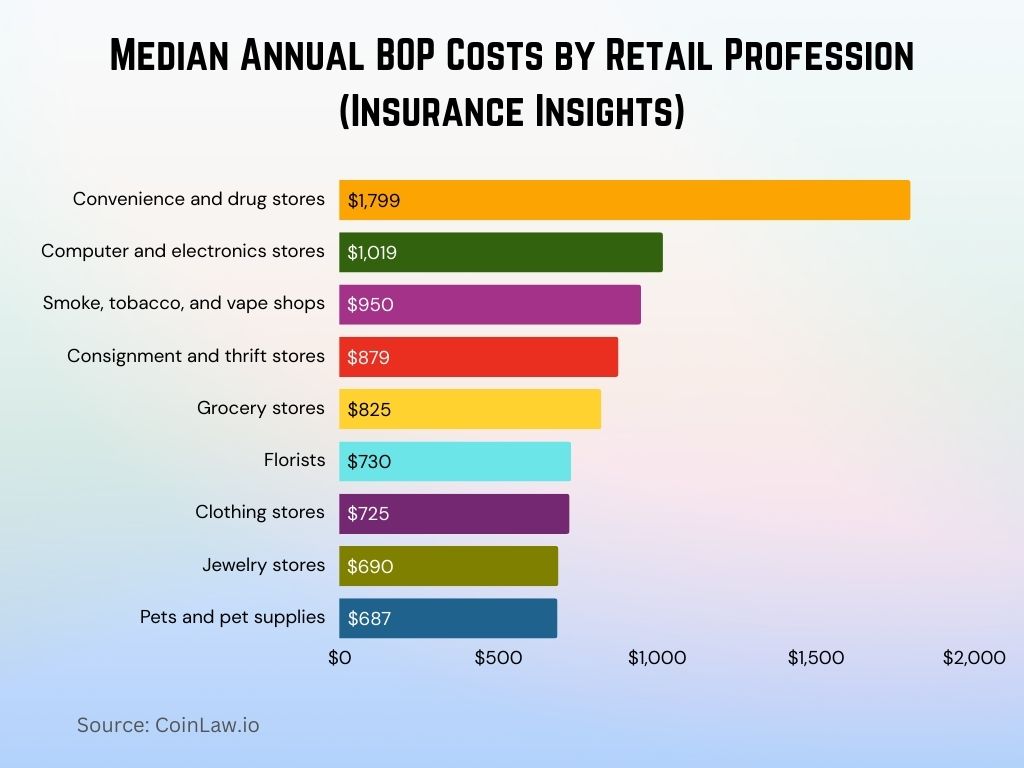The commercial insurance industry has been evolving rapidly, driven by a combination of economic factors, emerging risks, and technological advancements. As businesses worldwide face more complex risks, commercial insurance has become an essential tool to safeguard against potential financial losses. From protecting small businesses in local markets to covering global corporations, the industry plays a pivotal role in today’s economy. In 2025, the focus is on how the market will continue to grow, innovate, and adapt to emerging challenges. This article dives deep into the statistics behind this transformation, providing insights that will shape the future of the commercial insurance landscape.
Editor’s Choice: Key Market Growth Trends
- Global commercial insurance premiums are expected to exceed $940 billion in 2025.
- The commercial insurance market is projected to grow at a CAGR of 6.3% between 2025 and 2031, fueled by rising demand for risk mitigation and regulatory adherence.
- North America remains the largest market, contributing over 41% of global premiums, with continued expansion in the U.S. and Canada.
- Cyber insurance premiums are forecast to surpass $24 billion in 2025.
- Climate-related risks are driving up property insurance premiums, with an expected increase of 9% in 2025, as firms boost protection against extreme weather events.
- Digital transformation continues, with 82% of commercial insurers now investing in AI and machine learning to optimize risk evaluation and claims.
- Small and medium-sized enterprises (SMEs) account for 33% of new policy purchases in the U.S., pushing demand for customized insurance solutions.
Restaurant Business Insurance Trends
- In 2025, 62% of restaurant owners reported having business insurance, while 38% did not.
- In 2024, a higher 71% had business insurance, and only 29% were uninsured.
- There is a 9% drop in insurance coverage from 2024 to 2025, indicating a growing number of uninsured restaurant businesses.
- The percentage of uninsured restaurants increased by 9 points, from 29% in 2024 to 38% in 2025.

Market Share and Competitive Analysis
- The top 10 global insurers account for nearly 62% of total market share in 2025, led by AXA, Allianz, and Berkshire Hathaway.
- Allianz holds a 12.7% share of the global commercial insurance market in 2025, maintaining its leadership in the sector.
- AXA’s commercial insurance revenue grew by 5.2% in 2025, with a strong push into cyber and specialty insurance markets.
- Berkshire Hathaway posted over $76 billion in U.S. commercial insurance revenue in 2025, retaining a dominant national footprint.
- Zurich Insurance Group expanded in Europe and Asia, contributing to a 9.4% global market share in 2025.
- Lloyd’s of London wrote over $54 billion in premiums in 2025, maintaining its edge in complex specialty risks like aviation and marine.
- Insurtech firms, including Lemonade and Root, drove a 17% increase in policy sales in 2025, targeting small businesses with streamlined digital platforms.
Median Annual BOP Costs by Retail Profession (Insurance Insights)
- Convenience and drug stores have the highest BOP cost at $1,799 per year.
- Computer and electronics stores follow with a median cost of $1,019 annually.
- Smoke, tobacco, and vape shops incur around $950 in BOP expenses.
- Consignment and thrift stores pay approximately $879 per year for BOP coverage.
- Grocery stores face a median annual cost of $825.
- Florists spend about $730 annually on business owners’ policies.
- Clothing stores closely trail florists with a yearly BOP cost of $725.
- Jewelry stores see an average BOP cost of $690 each year.
- Pets and pet supply stores have the lowest BOP cost at $687 per year.

Commercial Insurance Market Trends
- Digitalization continues to accelerate, with over 75% of insurers offering digital platforms for policy management and claims processing in 2025.
- Embedded insurance adoption is rising, with an estimated 38% of commercial insurance distributed through embedded models in 2025.
- Climate-related losses are projected to reach $112 billion in 2025, pushing insurers to further revise risk models and premium structures.
- Telematics and IoT integration are expanding, with 43% of commercial auto insurance policies using real-time data to determine premium pricing in 2025.
- Parametric insurance is expected to grow by 22% from 2025 to 2028, offering faster payouts tied to defined risk events like natural disasters.
- Cyber risk remains a top threat, with 83% of global businesses identifying it as critical in 2025, fueling demand for specialized cyber coverage.
- Tailored insurance products are mainstream, with 58% of U.S. businesses now selecting customizable policies to address industry-specific risks.
Small Business Insurance in the U.S. at a Glance
- 97% of U.S. small businesses now carry some form of insurance in 2025, reflecting heightened risk management awareness.
- The average small business in the U.S. spends between $550 and $1,100 annually on general liability insurance in 2025.
- Employment Practices Liability Insurance (EPLI) adoption has increased, with 29% of small businesses adding it to their policies in 2025 due to rising employment-related lawsuits.
- Home-based businesses now make up 50% of all small business policies, as remote and hybrid work models become more permanent.

- Business interruption insurance is now held by 33% of small businesses in 2025, driven by a post-pandemic focus on operational resilience.
- Professional liability insurance remains the fastest-growing small business segment, with a 14% increase in demand in 2025, fueled by freelance and consulting growth.
- Cyber liability insurance has surged, with 32% of U.S. small businesses holding a policy in 2025.
Types of Small Business Insurance Required by Law
- Workers’ compensation insurance remains mandatory in 49 U.S. states in 2025, requiring coverage even for businesses with just 1 employee.
- Commercial auto insurance is legally required for any business-owned vehicle, with state-specific minimum liability limits ranging from $25,000 to $100,000.
- General liability insurance is still not universally required, but in 2025, over 60% of contractors must carry it to obtain permits or licenses, especially in construction and trades.
- Professional liability insurance (E&O) is legally mandated in 2025 for professions like law, accounting, and healthcare, ensuring accountability for professional errors.
- Disability insurance is required in states like New York, California, New Jersey, and Hawaii in 2025, covering non-work-related illnesses and injuries.
- Unemployment insurance is federally regulated and required for nearly all employers in 2025, supporting workers who lose their jobs involuntarily.
- Liquor liability insurance is legally required in over 30 states in 2025 for businesses that sell or serve alcohol, covering alcohol-related damages and incidents.
Commercial Building Insurance Costs in the UK (By Business Type)
- Gardening businesses face the highest annual premium at £381.
- Coffee shops closely follow, paying around £377 per year.
- Gift shops typically pay £275 annually for commercial building insurance.
- Beauty salons spend about £264 per year on coverage.
- Office services have the lowest cost, with a premium of just £238.

Casualty: Large Verdicts and Settlements Impact the Market
- Nuclear verdicts exceeding $10 million continue to rise, pushing casualty insurance premiums up by 7.1% in 2025 across major markets.
- General liability insurance premiums are expected to increase by 4.3% in 2025, driven by ongoing litigation in workplace injury and product liability cases.
- Social inflation remains a major cost driver, significantly impacting U.S. casualty premiums due to escalating jury awards and legal expenses.
- Umbrella and excess liability policies experienced an average rate hike of 8.5% in 2025, reflecting increased exposure to catastrophic claims.
- Workers’ compensation claims costs rose by 2% in 2025, with safety gains in construction and manufacturing keeping growth relatively stable.
- Mass tort litigation continues to elevate costs, particularly in pharmaceuticals and consumer goods, straining casualty insurers’ profitability.
- D&O liability insurance premiums increased by 5.7% in 2025, influenced by rising regulatory pressure and shareholder lawsuits.

Cyber Liability: Small Rate Decreases and Emerging Risks
- Cyber liability insurance premiums saw a modest decrease of 2.5% in 2025, as improved threat modeling helps stabilize the market after prior volatility.
- Ransomware continues to be the top cause of cyber claims, but stronger cyber defenses have enabled insurers to refine pricing models.
- 47% of small businesses now carry cyber liability coverage in 2025, showing growing adoption.
- Cloud security threats are on the rise, with 74% of businesses now hosting critical operations in the cloud, increasing demand for specialized cyber policies.
- The average cost of a U.S. data breach remains high at $4.7 million in 2025, prompting greater investment in breach prevention and response.
- Cyber insurance providers are expanding coverage to address AI and machine learning risks, which introduce new vulnerabilities not covered by legacy policies.
- Regulatory compliance continues to fuel demand, especially in response to stricter data privacy laws across California, Europe, and parts of Asia.
Recent Developments in Reinsurance and Premium Pricing
- Reinsurance premiums increased by 7.5% in 2025, driven by escalating catastrophe losses in regions vulnerable to hurricanes, floods, and wildfires.
- Alternative reinsurance capital, including insurance-linked securities (ILS), now represents 22% of the global reinsurance market in 2025, offering diversified risk-transfer options.
- Catastrophe bond issuances exceeded $13.4 billion in 2025, as insurers ramp up strategies to manage climate-related disaster exposure.
- European reinsurance markets, especially in Germany and France, saw premium increases of 6–9% in 2025 due to recurring extreme weather claims.
- Capacity constraints continue, with 83% of reinsurers tightening underwriting terms and pricing discipline in 2025 to manage volatility.
- Parametric reinsurance adoption is growing rapidly, particularly in disaster-prone areas, offering faster payouts triggered by measurable events.
- Reinsurance M&A activity rose by 6.2% in 2025, as firms pursue capital efficiency and market consolidation amid evolving risk landscapes.
Conclusion
As 2025 unfolds, the commercial insurance industry is set to experience significant changes driven by digital transformation, emerging risks, and the evolving regulatory environment. Businesses must stay ahead of these trends, adapting their insurance strategies to manage new risks effectively. With sectors like cyber liability, casualty, and property insurance undergoing rapid shifts, companies are seeking tailored solutions that address their unique needs. The continued integration of technology, coupled with a focus on sustainability and risk mitigation, will be crucial in shaping the future of commercial insurance. By understanding these key market dynamics, businesses can better prepare for the challenges and opportunities that lie ahead.


























































